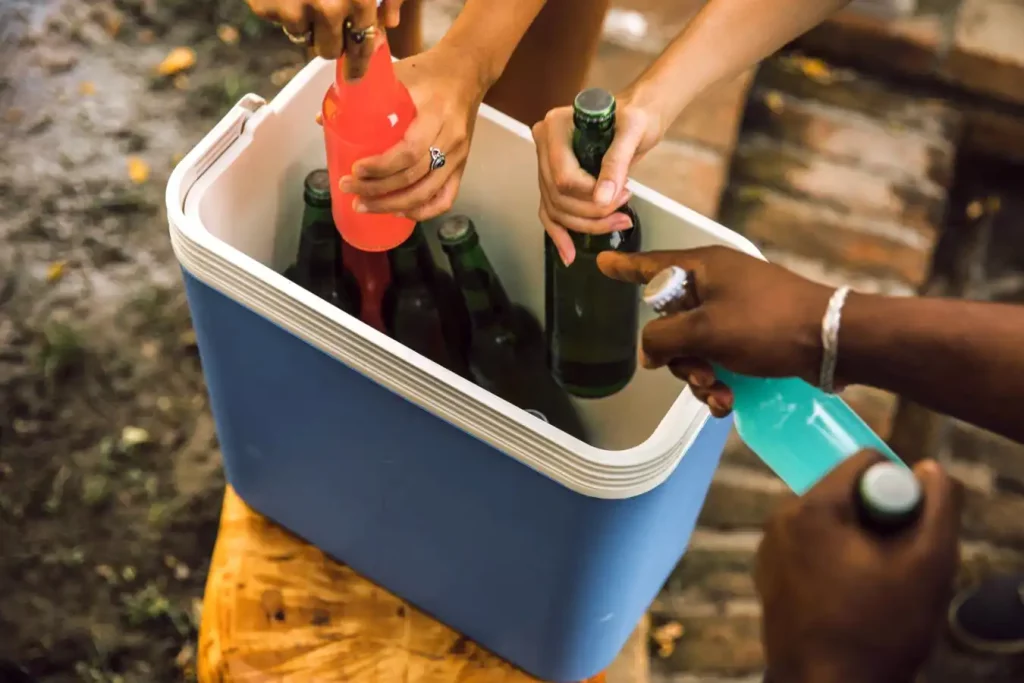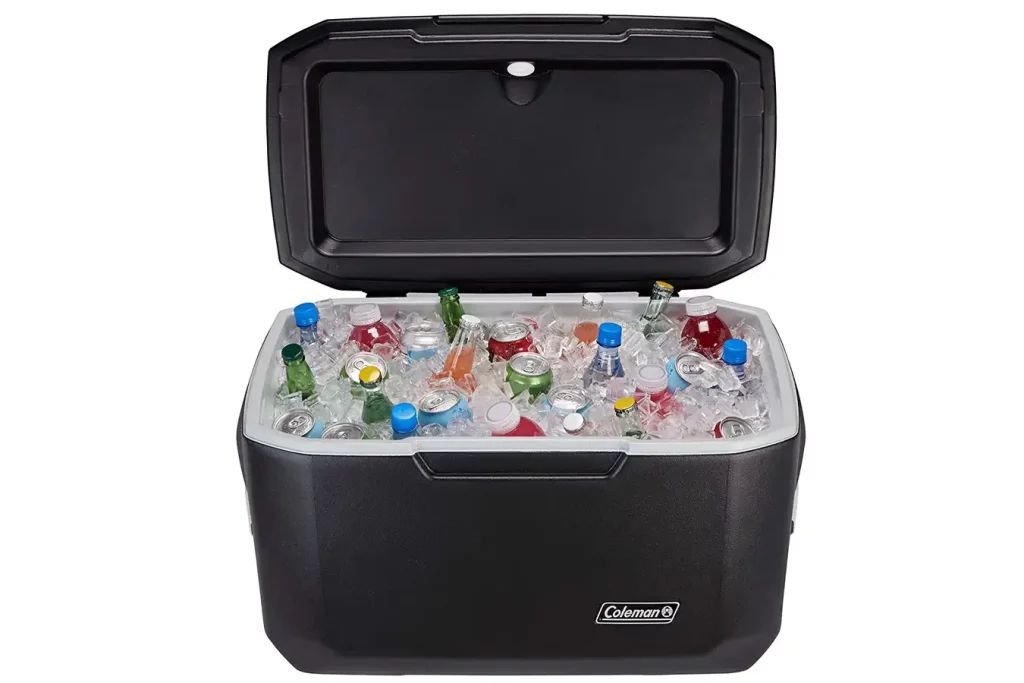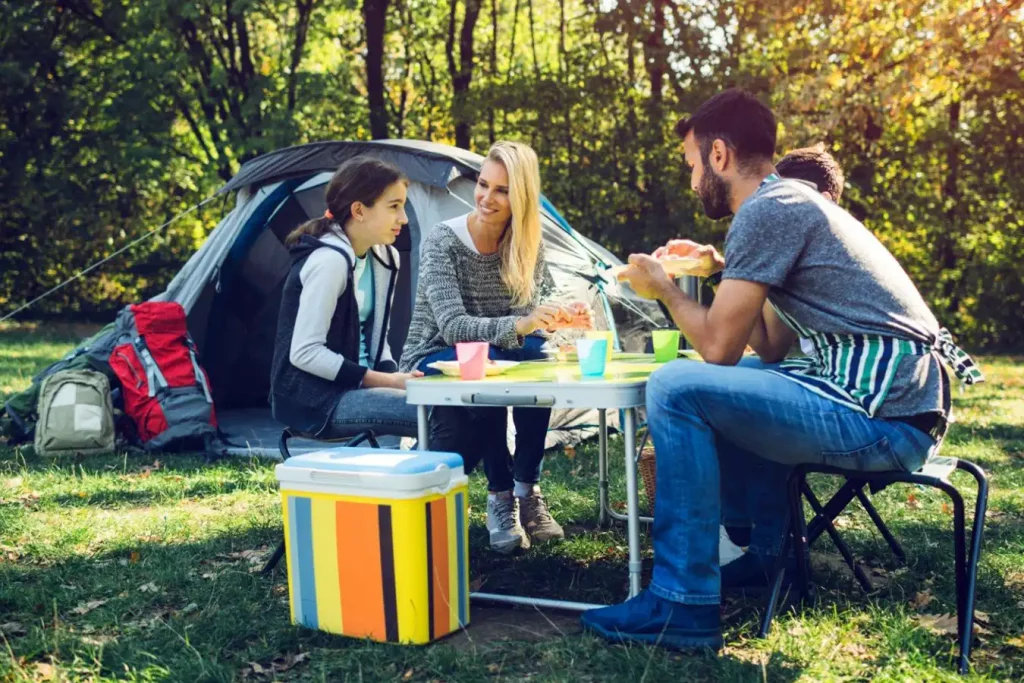“How big of a cooler do I need for camping?” you may ask.
This is a common question among outdoor enthusiasts, and rightfully so.
With this article, we aim to provide clear guidance on selecting the right size cooler for your camping trips.
Whether you’re planning a weekend getaway or a week-long adventure, having a cooler that meets your needs can make a world of difference.
Get ready to dive in, as we’re about to make your next camping preparation easier and more efficient.
Let’s embark on this journey together, just as we would on a tranquil camping trail.
Understanding Coolers and Their Sizes
Before we dive into the depths of cooler sizes, it’s crucial to have a basic understanding of what a camping cooler is and why it’s so important.
What is a Camping Cooler?
A camping cooler is essentially an insulated box designed to keep your food and beverages cool. It’s your best buddy when it comes to maintaining the freshness of your ingredients and preventing perishables from going bad. Plus, after a long day of hiking, what’s better than grabbing a cold drink from your cooler?

Typical Cooler Sizes
Camping coolers come in a wide range of sizes, each with their own pros and cons. The key is to choose one that aligns with your camping style, the length of your trip, and the number of people.
Small coolers, usually around 20 to 35 quarts, are perfect for short trips or solo camping. They’re lightweight and easy to carry, but they have a limited storage capacity. So, if you’re a fan of multi-day trips or camping with a group, this might not be the best choice.
Medium-sized coolers, falling in the range of 40 to 60 quarts, offer more storage space without being too bulky. They can hold supplies for a few days and are ideal for couples or small families.
Then, there are the large coolers, usually 70 quarts or more. These behemoths are designed for long trips or large groups. They offer ample storage space and excellent ice retention capabilities. However, their size and weight can be a bit cumbersome.
Remember, while choosing your cooler size, always factor in the space for ice or ice packs. A filled-to-the-brim cooler won’t keep your supplies cool for long. A good rule of thumb is to follow a 2:1 ratio of ice to contents.
Learn more: What Food Should I Bring for 3 Days Camping
Factors to Consider When Choosing a Cooler Size for Camping
So you now understand the basics of cooler sizes and what each range can offer. But before you make a purchase, there are several factors you should consider to ensure you’re choosing the perfect cooler for your needs. Let’s go over these key aspects:
Duration of the Camping Trip
One of the most significant factors influencing your choice of cooler size is the length of your camping trip. Are you planning a quick weekend getaway or a week-long adventure? The longer your journey, the larger cooler you’ll need.
For example, if you’re just heading out for a night or two, a small cooler (20 to 35 quarts) should suffice. However, for those week-long family camping trips, you’ll likely need a cooler that’s at least 70 quarts to store enough food, drinks, and ice to last the whole trip.
Number of People
The size of your camping crew significantly impacts the cooler size you’ll need. Simply put, more mouths to feed means more food and drinks, which in turn requires a larger cooler.
For solo or couple adventures, a small to medium-sized cooler should be ample. However, if you’re camping with a large family or a group of friends, opt for a larger cooler to ensure everyone’s needs are met.
Type of Food and Beverages
What you plan to eat and drink during your trip also plays a critical role in choosing the right cooler size. If you’re a fan of simple sandwiches and bottled water, a smaller cooler might work.
On the other hand, if you plan to bring perishable foods like meat or dairy products, or a variety of beverages, you’ll need a larger cooler to keep everything cold and fresh. Plus, you should always leave enough space for the ice or ice packs to maintain the cooler’s temperature.
Space and Portability
Lastly, consider the logistics. How much space do you have in your vehicle for a cooler? And once you’ve reached the campsite, will you be able to move the cooler around easily?
Larger coolers offer more storage, but they also take up more space and can be challenging to transport, especially when filled to the brim. Make sure the cooler you choose is a practical fit for your transportation and camping set-up.
By factoring in these considerations, you can ensure that you choose the right cooler for your camping needs. Because at the end of the day, camping is about enjoying the great outdoors, not worrying about if your cooler is up to the task.
Read more: How to Keep Eggs Cold While Camping
Recommended Cooler Sizes Based on Camping Needs
Choosing the right cooler size for your camping trip can be likened to packing the perfect camping bag — it’s all about planning for the days ahead and anticipating your needs. Below, I’ve suggested some cooler sizes based on the length of your camping trip.
Short Trips (1-2 days)
For short camping trips, a cooler between 20 to 35 quarts should be sufficient. This size is ideal for solo campers or a couple, as it can easily accommodate food and drinks for a day or two, along with the necessary ice or ice packs.
Medium Trips (3-5 days)
If you’re planning to commune with nature for a little longer — say 3 to 5 days — a medium-sized cooler in the range of 40 to 60 quarts will serve you well. It can handle a more significant amount of food and beverages, which is perfect if you’re a small family or group.

Long Trips (More than 5 days)
For long-term camping adventures that stretch beyond five days, you’ll need a cooler that’s up for the task. A large cooler, usually 70 quarts or more, will provide the storage and ice retention necessary for these extended trips.
Now, let’s break this down into a handy table:
| Duration of Camping | Cooler Size (in Quarts) |
|---|---|
| 1-2 days (Short Trips) | 20-35 |
| 3-5 days (Medium Trips) | 40-60 |
| More than 5 days (Long Trips) | 70 or more |
Remember, these are rough estimates, and your actual needs might vary based on factors we discussed earlier — the number of people, type of food and beverages, and space and portability considerations.
In short, the size of your camping cooler depends on trip duration, group size, food type, and transport space, typically ranging from 20 to 70 quarts.
Tips for Maximizing Cooler Efficiency
Choosing the right cooler size is just the first step. To ensure your cooler works efficiently throughout your trip, here are a few pro tips:
- Pre-cool Your Cooler: Before packing, chill your cooler for a few hours. This helps maintain the cold temperature longer.
- Pack Strategically: Place ice at the bottom, followed by food and drinks. Top up with more ice to fill gaps. This way, cold air, which is denser, stays at the bottom, cooling everything evenly.
- Use Ice Blocks: While ice cubes cool faster, ice blocks last longer, making them a better choice for extended trips.
- Keep it Full: A full cooler stays colder longer. If you have extra space, fill it with additional ice or ice packs.
- Limit Opening: Every time you open the cooler, cold air escapes. Try to minimize opening the cooler and close it immediately after use.
See also: How to Keep Meat Cold While Camping
FAQs about Camping Cooler Size for Campers
What size cooler for camping weekend?
What size cooler for camping with a family of 4?
How do I know what size cooler I need?
How much can you fit in a 45-quart cooler?
Conclusion
Choosing the right cooler size for your camping trip can greatly enhance your outdoor experience. By considering factors such as trip duration, number of people, type of food and beverages, and space and portability, you can select a cooler that perfectly meets your needs.
This guide offers a general recommendation on cooler sizes based on your camping needs. However, remember that each camping trip is unique, and your needs may vary. Always plan and pack with your specific journey in mind.
In conclusion, a cooler is not just a box to keep your drinks cold or food fresh; it’s a crucial part of your camping adventure. So, choose wisely, pack efficiently, and focus on making memories amidst nature’s beauty. After all, the wild is waiting, and your next adventure is just a cooler away. Happy camping, my fellow outdoor enthusiasts!
To know more: How to Use Dry Ice for Camping


